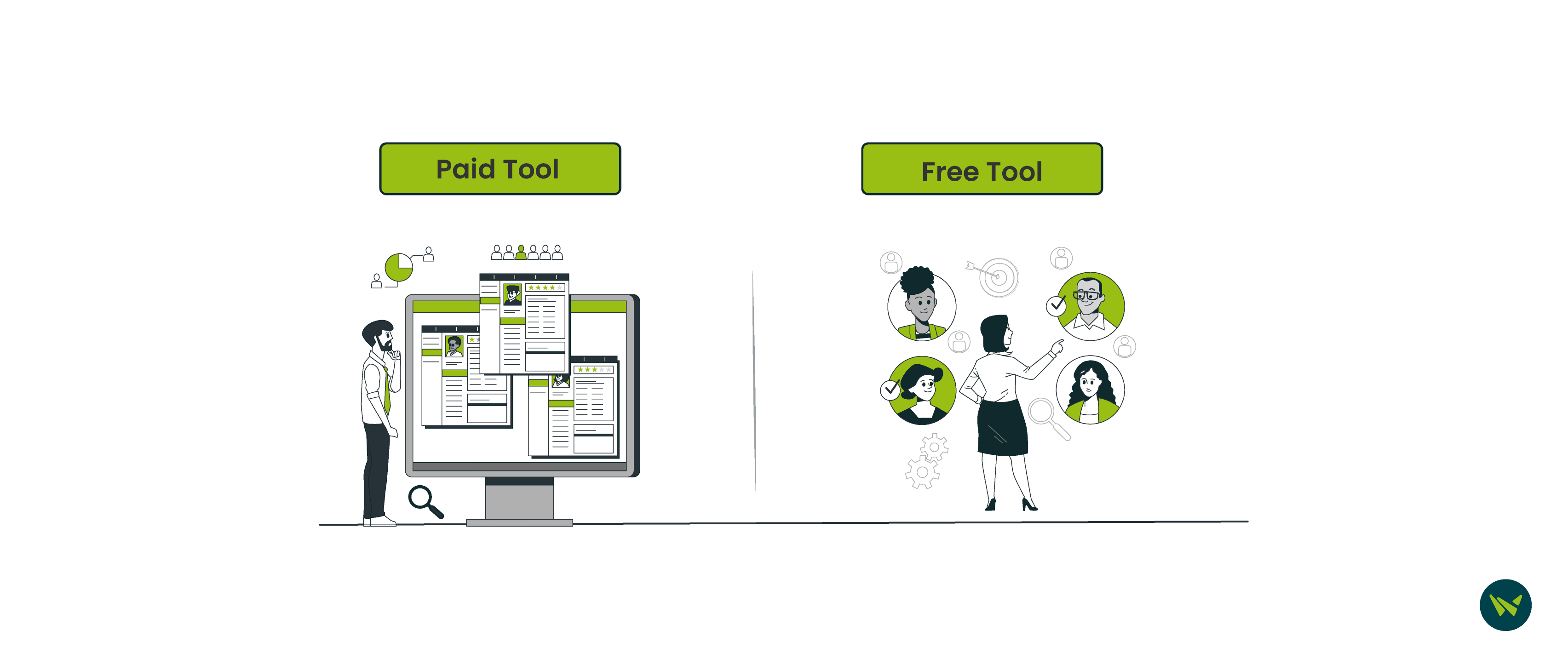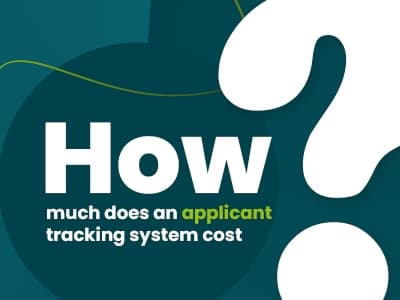When considering an applicant tracking system (ATS) for your business, one of the first questions is: How much will it cost? In this guide, we break down the typical pricing for ATS software for small, mid-sized, and large businesses. We’ll also compare popular ATS platforms, highlight free ATS options, and discuss when a free tool might suffice (and when it’s time to upgrade). In the end, we’ll look at factors that impact ATS pricing and reveal some hidden costs to watch out for. Let's get started!

Small Businesses (<100 Employees)
Small companies with limited hiring needs can usually work with entry-level ATS tools that keep costs down. In fact, many vendors offer per-user, per-vacancy, or flat-fee pricing, with base plans starting at $50 to $100 per month. That totals roughly $250 to $3,000 per year, depending on features and usage.
Mid-Sized Businesses (100–500 Employees)
On average, mid-sized companies pay between $3,000 to $15,000 per year for an ATS, depending on usage and feature depth. That’s almost $250 to $1,250 per month. Pricing can be per user or at a flat rate, with some vendors offering bulk discounts. These platforms typically unlock more advanced tools—like job posting automation, interview scheduling, and customizable workflows—making them better suited for companies hiring across multiple departments or locations.
Large Businesses (500–5,000 Employees)
Many enterprise ATS vendors do not publicly list prices and instead offer custom quotes. However, industry data shows that companies with a few hundred to a few thousand employees may pay on the order of $15,000 to $50,000+ per year for an ATS. That equates to roughly $1,250 to $4,000+ per month. At this level, you can expect support for custom workflows, robust analytics, HR system integrations, and dedicated account support.
Company | Pricing |
Workable | While Workable offers multiple pricing tiers, published rates indicate the platform starts at $169/month for up to 20 employees under the Starter plan |
Greenhouse | Greenhouse doesn’t list pricing publicly, but reports suggest it starts around $6,000/year (approximately $500/month) for small teams of about 10 users |
Lever | Although Lever doesn’t disclose pricing upfront, estimates suggest the Core ATS plan begins at $800–$900/month |
Zoho Recruit | Zoho Recruit offers multiple pricing tiers, starting at $30/user/month for the Standard plan. A free forever plan is also available, but it limits you to managing one job posting at a time |
JazzHR | JazzHR starts at $75/month for the Hero plan, which includes 3 active jobs. Additional jobs can be added for $9/job/month |
Breezy HR | Breezy HR starts at $189/month for the Startup plan. A free plan is also available, which covers the basics for one position or talent pool |
Recruitee | Recruitee starts at $270/month for the Start plan with 5 job slots and unlimited users. Its higher plans offer unlimited slots |
GoHire | GoHire starts at $99/month for the Starter plan, which includes 3 active job posts and unlimited users. Its higher plans offer expanded job posting limits with additional features |
Disclaimer: The pricing has been sourced from third-party websites and is subject to change.
In short, yes. There are several free-to-use ATS platforms or free tiers of ATS software that can be sufficient for startups or small teams on a tight budget. Below is a list of ATS solutions that offer a free version, along with a brief description:
Free ATS System Table
Free ATS Platform | Description |
Breezy HR (Bootstrap) | Its free plan includes 1 active position and 1 candidate pool with unlimited team members. It supports job board posting to 50+ sites and resume parsing, but access to full candidate data is limited to the most recent 30 days |
Dover | Dover’s free plan supports unlimited jobs, candidates, and users, including a 20-minute onboarding call. As a completely free platform, it’s appealing for small teams, though being a newer tool, it’s worth checking if it meets long-term needs |
iKrut | Aside from its 28-day free trial of the upgraded version, it offers a free plan with unlimited job postings and users, along with basic applicant tracking and candidate management tools. Free email support is also included |
Indeed (Employer Dashboard) | Indeed offers a basic ATS for free when jobs are posted through its platform. Employers get access to tools like resume viewing, interview scheduling, and candidate tracking. However, the ATS is only available if you're posting jobs directly on Indeed |
Jobsoid (Free Beginner Plan) | Its free plan includes 1 active job, 1 user, and unlimited candidates. It also offers features like one-click job board posting and a branded careers page, but access is limited to a single user account |
MightyRecruiter | A rare example of a completely free end-to-end ATS with no paid version at all. It allows for unlimited job postings, candidates, and users with a full suite of standard ATS features. It even provides a dedicated account manager and support channels for all users |

The thing is, free ATS tools can be ‘good enough’ for certain scenarios: for example, a very small business hiring only a couple of roles a year might manage with a free or freemium ATS. Free plans offer basic applicant tracking functionality with minimal investment, making them ideal for tight budgets or those looking to try an ATS before committing.
Many free systems (like those listed above) handle core tasks such as posting to free job boards, basic candidate tracking, and maybe limited resume search. If your recruiting volume is low, such as managing one active job at a time, and you don’t require advanced integrations or analytics, a free ATS could suffice.
However, if you find yourself hitting the limits of your free ATS, it might be time to upgrade. For example, you may have more open requisitions than the system allows you to handle. You could be spending time on tedious manual tasks that a paid plan would automate, like screening resumes or scheduling interviews. Additionally, if you require reporting tools to optimize your recruitment process, investing in a paid ATS would be a practical decision

ATS pricing can seem confusing at first, with different vendors using different models. However, most pricing comes down to a few key factors and usage metrics. Here are the main elements that influence how much an ATS will cost:
- Number Of Users (Seats Or Recruiters): Many ATS platforms charge based on the number of people who will be using the system on the recruiting side—this is the pay-per-user or pay-per-recruiter model. If you have 5 recruiters, you’ll be charged for each seat. Some vendors use pricing ranges (e.g., 1–10 users), while others offer a flat fee up to a certain number, then charge extra. This also includes hiring managers or coordinators who may need access, so the total number of users directly impacts the price
- Number Of Job Postings Or Hiring Volume: Another pricing factor is how many open roles you plan to manage at once. In a pay-per-job model, your plan might include a set number of jobs, with charges for any extras. You’ll often see tiers like ‘up to 3 jobs’ or ‘up to 50 jobs.’ If you hire in volume, you’ll likely need a higher-tier plan. If you hire occasionally, usage-based pricing helps avoid overpaying
- Feature Set And Modules: ATS platforms usually come in tiers—Basic, Pro, Enterprise—with higher plans offering more features. Basic might include the core ATS and email templates, while higher plans add onboarding, assessments, or analytics. Some vendors also use a pay-per-module model, where key tools like background checks cost extra. A lower base price can end up more expensive if important features aren’t included
Now you know exactly how much does an applicant tracking system cost. Keep in mind that the right ATS is an investment—it saves time and improves your hiring process. That’s why it’s just as important to focus on value (features and efficiency gained) as it is to focus on price. Use the information in this guide to make an informed decision, or visit our resource center for more detailed information.
